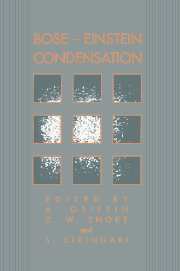Book contents
- Frontmatter
- Contents
- Preface
- Preface to paperback edition
- 1 Introduction: Unifying Themes of Bose–Einstein Condensation
- Part one Review Papers
- Part two Brief Reports
- 20 BEC in Ultra-cold Cesium: Collisional Constraints
- 21 BEC and the Relaxation Explosion in Magnetically Trapped Atomic Hydrogen
- 22 Quest for Kosterlitz–Thouless Transition in Two-Dimensional Atomic Hydrogen
- 23 BEC of Biexcitons in CuCl
- 24 The Influence of Polariton Effects on BEC of Biexcitons
- 25 Light-Induced BEC of Excitons and Biexcitons
- 26 Evolution of a Nonequilibrium Polariton Condensate
- 27 Excitonic Superfluidity in Cu2O
- 28 On the Bose–Einstein Condensation of Excitons: Finite-lifetime Composite Bosons
- 29 Charged Bosons in Quantum Heterostructures
- 30 Evidence for Bipolaronic Bose-liquid and BEC in High-Tc Oxides
- 31 The Dynamic Structure Function of Bose Liquids in the Deep Inelastic Regime
- 32 Possibilities for BEC of Positronium
- 33 Bose–Einstein Condensation and Spin Waves
- 34 Universal Behaviour within the Nozières–Schmitt-Rink Theory
- 35 Bound States and Superfluidity in Strongly Coupled Fermion Systems
- 36 Onset of Superfluidity in Nuclear Matter
- Appendix. BEC 93 Participant List
- Index
25 - Light-Induced BEC of Excitons and Biexcitons
Published online by Cambridge University Press: 15 December 2009
- Frontmatter
- Contents
- Preface
- Preface to paperback edition
- 1 Introduction: Unifying Themes of Bose–Einstein Condensation
- Part one Review Papers
- Part two Brief Reports
- 20 BEC in Ultra-cold Cesium: Collisional Constraints
- 21 BEC and the Relaxation Explosion in Magnetically Trapped Atomic Hydrogen
- 22 Quest for Kosterlitz–Thouless Transition in Two-Dimensional Atomic Hydrogen
- 23 BEC of Biexcitons in CuCl
- 24 The Influence of Polariton Effects on BEC of Biexcitons
- 25 Light-Induced BEC of Excitons and Biexcitons
- 26 Evolution of a Nonequilibrium Polariton Condensate
- 27 Excitonic Superfluidity in Cu2O
- 28 On the Bose–Einstein Condensation of Excitons: Finite-lifetime Composite Bosons
- 29 Charged Bosons in Quantum Heterostructures
- 30 Evidence for Bipolaronic Bose-liquid and BEC in High-Tc Oxides
- 31 The Dynamic Structure Function of Bose Liquids in the Deep Inelastic Regime
- 32 Possibilities for BEC of Positronium
- 33 Bose–Einstein Condensation and Spin Waves
- 34 Universal Behaviour within the Nozières–Schmitt-Rink Theory
- 35 Bound States and Superfluidity in Strongly Coupled Fermion Systems
- 36 Onset of Superfluidity in Nuclear Matter
- Appendix. BEC 93 Participant List
- Index
Summary
Abstract
We review the theory of coherent pairing of excitons and biexcitons in two-dimensional and three-dimensional semiconductor structures.
Introduction
The coherent pairing of bosons, formally analogous to Cooper pairing of electrons in superconductors, and the coexistence of particle and pair Bose–Einstein condensation (BEC) was first studied in Refs. [1–4]. BEC of excitons in semiconductors was investigated using the approximation of coherent pairing of the electrons and holes [5]. Later on, the idea of coherent pairing of bosons was applied to excitons [6–8]. In Ref. [6], it was assumed that the boson pairs consist of two electron–hole pairs instead of two excitons, and it was suggested that the new collective state is a BEC even though the two-pair bound state does not exist. It was proved independently [7, 8] that in a system of bosons and excitons with an attractive pair interaction sufficient for biexciton formation, the coherent pairing of excitons with momenta k and −k coincides with the BEC of biexcitons with zero translational momentum.
The possibility of particle and pair BEC in a system of four species of excitons with different values of spin projections of the electron and hole was studied in Ref. [9]. It is known [10, 11] that the interaction of an exciton of either type with other exciton species is repulsive on the average, but that pairs of excitons with antiparallel spins of electrons and holes interact attractively, and biexcitons can be formed.
- Type
- Chapter
- Information
- Bose-Einstein Condensation , pp. 507 - 512Publisher: Cambridge University PressPrint publication year: 1995



